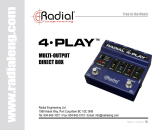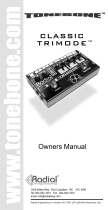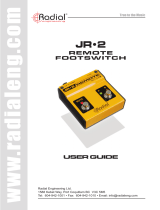
www.radialeng.com
True to the Music
Radial Engineering Ltd.
®
®
True to the Music
USER GUIDE
Radial Engineering Ltd.
Texas-Pro
™
Texas-Pro
™
FEATURES
RADIAL ENGINEERING 3 YEAR
TRANSFERABLE LIMITED WARRANTY
RADIAL ENGINEERING LTD. (“Radial”) warrants this product to be free from defects in
material and workmanship and will remedy any such defects free of charge according to the
terms of this warranty. Radial will repair or replace (at its option) any defective component(s)
of this product (excluding nish and wear and tear on components under normal use) for
a period of three (3) years from the original date of purchase. In the event that a particular
product is no longer available, Radial reserves the right to replace the product with a similar
product of equal or greater value. In the unlikely event that a defect is uncovered, please call
604-942-1001 or email [email protected] to obtain an RA number (Return Authorization
number) before the 3 year warranty period expires. The product must be returned prepaid
in the original shipping container (or equivalent) to Radial or to an authorized Radial repair
center and you must assume the risk of loss or damage. A copy of the original invoice showing
date of purchase and the dealer name must accompany any request for work to be performed
under this limited and transferable warranty. This warranty shall not apply if the product has
been damaged due to abuse, misuse, misapplication, accident or as a result of service or
modication by any other than an authorized Radial repair center.
THERE ARE NO EXPRESSED WARRANTIES OTHER THAN THOSE ON THE FACE
HEREOF AND DESCRIBED ABOVE. NO WARRANTIES WHETHER EXPRESSED
OR IMPLIED, INCLUDING BUT NOT LIMITED TO, ANY IMPLIED WARRANTIES OF
MERCHANTABILITY OR FITNESS FOR A PARTICULAR PURPOSE SHALL EXTEND
BEYOND THE RESPECTIVE WARRANTY PERIOD DESCRIBED ABOVE OF THREE
YEARS. RADIAL SHALL NOT BE RESPONSIBLE OR LIABLE FOR ANY SPECIAL,
INCIDENTAL OR CONSEQUENTIAL DAMAGES OR LOSS ARISING FROM THE USE OF
THIS PRODUCT. THIS WARRANTY GIVES YOU SPECIFIC LEGAL RIGHTS, AND YOU
MAY ALSO HAVE OTHER RIGHTS, WHICH MAY VARY DEPENDING ON WHERE YOU
LIVE AND WHERE THE PRODUCT WAS PURCHASED.
Texas-Pro
™
User Guide - Part# R870 1024 00 / 11-2016 All rights reserved.
Specications and appearance are subject to change without notice.
Radial Engineering Ltd.
1588 Kebet Way, Port Coquitlam BC V3C 5M5
tel: 604-942-1001 • fax: 604-942-1010
[email protected] • www.radialeng.com
Circuit Type: .......................................................................... Class-A discrete
Frequency Response: .......................Adjustable via tone and range controls
Gain – Boost: ...................................................... Variable from 0dB to +22dB
Gain – Overdrive: .............................................Variable from +2dB to +30dB
Footswitch - Drive: ................................... Latching switch engages overdrive
Footswitch - Boost: ..............Latching switch engages boost and effects loop
Effects Loop: ....Send & return jacks for additional pedals before boost stage
Power: .................................................................9VDC, adapter not included
Radial Texas-Pro Specications
OVERDRIVE & BOOST PEDAL
1. INPUT: High-Z ¼” connection from your instrument.
2. EFX LOOP: Send and return ¼” jacks used to connect effect
pedals.
3. OUTPUT: ¼” connection to your amplier.
4. 9VDC POWER: Connection for 9 volt (center pin negative)
power adapter. Includes a cable clamp to prevent accidental
power disconnection.
5. LEVEL: Used to set the output volume level for the overdrive.
6. TONE: Brightens or darkens the Overdrive circuit to suit your
guitar and amp setup.
7. DRIVE: Used to adjust the overall amount of distortion
introduced in the Overdrive circuit.
8. RANGE: 3-position switch used to tailor the output of the
Overdrive to suit your guitar and amp setup.
9. DRIVE FOOTSWITCH: Used to activate the Overdrive circuit.
10. BOOST FOOTSWITCH: Activates the power booster and the
effects loop.
11. BOOST GAIN: Variable Class-A power booster – 100% discrete
with up to +22dB of clean gain.
11
10
9
7
8
34 2 1
5
6

Radial Engineering Ltd. Radial Engineering Ltd. Radial Engineering Ltd.
Texas-Pro
™
Texas-Pro
™
Texas-Pro
™
OVERVIEW
Thank you for your purchase of the Tonebone Texas-Pro, a versatile new
pedal that provides you with a wide range of tonal possibilities. The Texas-Pro
is like having two separate pedals in one, an overdrive and a power booster.
You have the option to use either feature on its own, or engage them both
simultaneously for a powerful combo.
Before you start using the Texas-Pro, please take a few minutes to review
this short user guide and get better acquainted with the various features of
this unique pedal. For additional information you can visit the Radial website,
where we post answers to frequently asked questions along with updates.
Should you nd that you still need more information on the Texas-Pro, feel
free to drop us a line at [email protected] and we will do our best to get
back to you in short order.
MAkING CONNECTIONS
Before you connect to the Texas-Pro, make sure to turn your guitar amp
down or off to avoid loud turn-on transients that can cause damage to your
amplier. There is no power switch on the Texas-Pro, you simply connect
to a 9V supply and the unit will turn on. You can check that it is receiving
power by depressing one of the footswitches to see if the LED illuminates.
The Texas-Pro does not come with a power supply as most players will use a
multi-pedal power brick on their pedalboard. You can use a standard Boss®
style 9V adapter for power, with a 2.1mm barrel connector wired for center-
pin negative polarity. The power cable can be afxed to the pedal using the
cable lock provided, preventing accidental disconnection. Use a hex key to
unscrew the cable lock, pass the cable through the cavity and then retighten.
THE OVERDRIVE
Start with the LEVEL and TONE controls at 12 o’clock and the DRIVE control set
to 9 o’clock. Next, turn your amp on and the volume up and depress the DRIVE
footswitch. Test out different settings on the LEVEL control to get an idea of the
range of the Overdrive, as it can provide a lot of gain to your signal. Now you can
experiment with the TONE and DRIVE settings. The TONE control will add more
high frequency content as you turn it clockwise. All three of these controls interact,
so increasing the DRIVE will also increase the overall output level.
THE RANGE
The 3-position RANGE switch has three settings: Vintage, Modern and Maximum.
Each of these options will provide a different avor of overdrive, from a bluesy
vintage style to a beeer modern tone, or a maxed-out aggressive voicing with
plenty of saturation. Try each setting out while also changing the TONE control
to explore the limitless possibilities for your tone.
THE BOOSTER
Start with the BOOST level down at 7 o’clock. Turn off the Overdrive, engage the
BOOST footswitch and listen as you increase the volume. You can use the Boost
function for high-output soloing, or to push the front end of your amp harder. When
the Boost is activated it will also engage the effects loop, bringing your effects
pedals into the signal chain after the Overdrive section and before the Boost.
INPUT
DRIVE TONE LEVEL
F/X LOOP
SND RTN
OVERDRIVE
RANGE
TRUE BYPASS SWITCHING
POWER BOOSTER
GAIN
OUTPUT
TRUE BYPASS SWITCHING
Class-A
MODERN
MAXIMUM
VINT
1) Connecting a tuner
You can connect a tuner to the effects SEND jack and when the Boost is
engaged, it will shut off the signal going to the amp for quiet on-stage tuning.
2) Connecting a second amp
You can also connect a second guitar amp using the effects send. However,
as this output is not isolated, you may experience a ground loop. To minimize
the possibility of noise, make sure both amps are connected to the same
electrical circuit using a power bar. Also, make sure both amps have a proper
U-ground attached for safety.
3) Connecting a second guitar
You can connect a second guitar to the Texas-Pro by using the effects
RETURN jack. This will bypass the Overdrive circuit and feed directly into
the Booster when activated.
THE EFFECTS LOOP
The built-in effects loop allows you to
connect a series of pedals that are
brought into the signal chain when you
engage the BOOST footswitch. This
allows you to simultaneously activate
the Booster and a delay or chorus
pedal, giving you a more streamlined
and professional transition for soloing.
The effects loop employs standard ¼”
guitar cable connections.
ALTERNATIVE EFFECT LOOP SET-UPS
/










